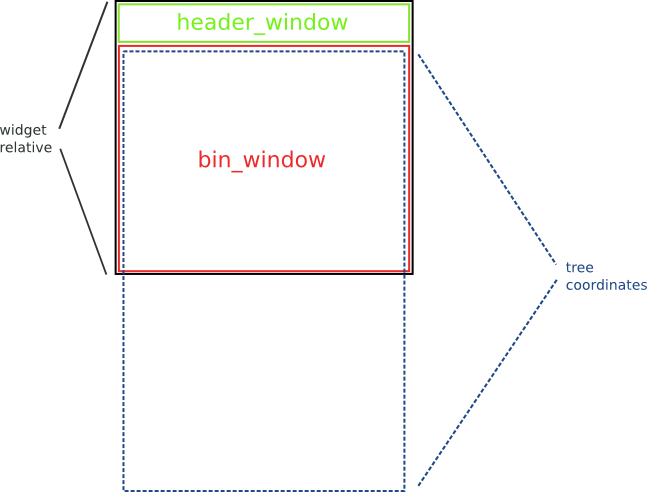Struct gtk4::TreeView [−][src]
pub struct TreeView(_);Expand description
A widget for displaying both trees and lists
Widget that displays any object that implements the TreeModel interface.
Please refer to the tree widget conceptual overview for an overview of all the objects and data types related to the tree widget and how they work together.
Coordinate systems in GtkTreeView API
Several different coordinate systems are exposed in the TreeView API.
These are:

-
Widget coordinates: Coordinates relative to the widget (usually
widget->window). -
Bin window coordinates: Coordinates relative to the window that GtkTreeView renders to.
-
Tree coordinates: Coordinates relative to the entire scrollable area of GtkTreeView. These coordinates start at (0, 0) for row 0 of the tree.
Several functions are available for converting between the different
coordinate systems. The most common translations are between widget and bin
window coordinates and between bin window and tree coordinates. For the
former you can use TreeViewExt::convert_widget_to_bin_window_coords()
(and vice versa), for the latter TreeViewExt::convert_bin_window_to_tree_coords()
(and vice versa).
TreeView as Buildable
The TreeView implementation of the Buildable interface accepts
TreeViewColumn objects as <child> elements and exposes the
internal TreeSelection in UI definitions.
An example of a UI definition fragment with TreeView:
<object class="GtkTreeView" id="treeview">
<property name="model">liststore1</property>
<child>
<object class="GtkTreeViewColumn" id="test-column">
<property name="title">Test</property>
<child>
<object class="GtkCellRendererText" id="test-renderer"/>
<attributes>
<attribute name="text">1</attribute>
</attributes>
</child>
</object>
</child>
<child internal-child="selection">
<object class="GtkTreeSelection" id="selection">
<signal name="changed" handler="on_treeview_selection_changed"/>
</object>
</child>
</object>CSS nodes
treeview.view
├── header
│ ├── button
│ │ ╰── [sort-indicator]
┊ ┊
│ ╰── button
│ ╰── [sort-indicator]
│
├── [rubberband]
╰── [dndtarget]TreeView has a main CSS node with name treeview and style class .view.
It has a subnode with name header, which is the parent for all the column
header widgets’ CSS nodes.
Each column header consists of a button, which among other content, has a
child with name sort-indicator, which carries the .ascending or .descending
style classes when the column header should show a sort indicator. The CSS
is expected to provide a suitable image using the -gtk-icon-source property.
For rubberband selection, a subnode with name rubberband is used.
For the drop target location during DND, a subnode with name dndtarget is used.
Implements
TreeViewExt, WidgetExt, glib::ObjectExt, AccessibleExt, BuildableExt, ConstraintTargetExt, ScrollableExt, TreeViewExtManual, WidgetExtManual, AccessibleExtManual
Implementations
Creates a new builder-pattern struct instance to construct TreeView objects.
This method returns an instance of TreeViewBuilder which can be used to create TreeView objects.
Trait Implementations
This method returns an ordering between self and other values if one exists. Read more
This method tests less than (for self and other) and is used by the < operator. Read more
This method tests less than or equal to (for self and other) and is used by the <=
operator. Read more
This method tests greater than (for self and other) and is used by the > operator. Read more
Returns the type identifier of Self.
Auto Trait Implementations
impl RefUnwindSafe for TreeView
impl UnwindSafe for TreeView
Blanket Implementations
Mutably borrows from an owned value. Read more
Upcasts an object to a superclass or interface T. Read more
Upcasts an object to a reference of its superclass or interface T. Read more
Tries to downcast to a subclass or interface implementor T. Read more
Tries to downcast to a reference of its subclass or interface implementor T. Read more
Tries to cast to an object of type T. This handles upcasting, downcasting
and casting between interface and interface implementors. All checks are performed at
runtime, while downcast and upcast will do many checks at compile-time already. Read more
Tries to cast to reference to an object of type T. This handles upcasting, downcasting
and casting between interface and interface implementors. All checks are performed at
runtime, while downcast and upcast will do many checks at compile-time already. Read more
Casts to T unconditionally. Read more
Casts to &T unconditionally. Read more
Returns true if the object is an instance of (can be cast to) T.
pub fn set_property<'a, N, V>(
&self,
property_name: N,
value: V
) -> Result<(), BoolError> where
N: Into<&'a str>,
V: ToValue,
pub fn set_property_from_value<'a, N>(
&self,
property_name: N,
value: &Value
) -> Result<(), BoolError> where
N: Into<&'a str>,
pub fn set_properties_from_value(
&self,
property_values: &[(&str, Value)]
) -> Result<(), BoolError>
pub fn has_property<'a, N>(&self, property_name: N, type_: Option<Type>) -> bool where
N: Into<&'a str>,
pub fn find_property<'a, N>(&self, property_name: N) -> Option<ParamSpec> where
N: Into<&'a str>,
Safety Read more
Safety Read more
Safety Read more
Safety Read more
pub fn connect<'a, N, F>(
&self,
signal_name: N,
after: bool,
callback: F
) -> Result<SignalHandlerId, BoolError> where
N: Into<&'a str>,
F: 'static + Fn(&[Value]) -> Option<Value> + Send + Sync,
Same as connect but takes a SignalId instead of a signal name.
pub fn connect_local<'a, N, F>(
&self,
signal_name: N,
after: bool,
callback: F
) -> Result<SignalHandlerId, BoolError> where
N: Into<&'a str>,
F: 'static + Fn(&[Value]) -> Option<Value>,
Same as connect_local but takes a SignalId instead of a signal name.
pub unsafe fn connect_unsafe<'a, N, F>(
&self,
signal_name: N,
after: bool,
callback: F
) -> Result<SignalHandlerId, BoolError> where
N: Into<&'a str>,
F: Fn(&[Value]) -> Option<Value>,
Same as connect_unsafe but takes a SignalId instead of a signal name.
Emit signal by signal id.
Same as emit but takes Value for the arguments.
Emit signal by its name.
Same as emit_by_name but takes Value for the arguments.
Emit signal with details by signal id.
Same as emit_with_details but takes Value for the arguments.
pub fn connect_notify<F>(&self, name: Option<&str>, f: F) -> SignalHandlerId where
F: 'static + Fn(&T, &ParamSpec) + Send + Sync,
pub fn connect_notify_local<F>(
&self,
name: Option<&str>,
f: F
) -> SignalHandlerId where
F: 'static + Fn(&T, &ParamSpec),
pub unsafe fn connect_notify_unsafe<F>(
&self,
name: Option<&str>,
f: F
) -> SignalHandlerId where
F: Fn(&T, &ParamSpec),
pub fn bind_property<'a, O, N, M>(
&'a self,
source_property: N,
target: &'a O,
target_property: M
) -> BindingBuilder<'a> where
O: ObjectType,
N: Into<&'a str>,
M: Into<&'a str>,
Returns a SendValue clone of self.